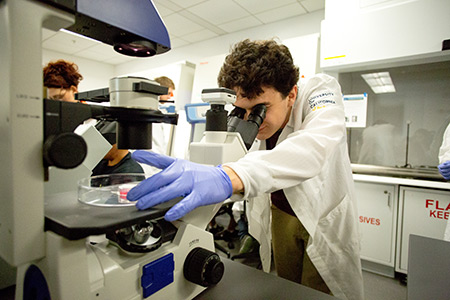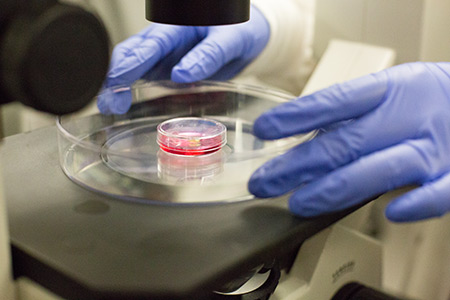
 There are many labs at UC Merced where visitors can see students huddled over microscopes and petri dishes, using tweezers to extract and examine different items. But no one at UC Merced has ever seen the likes of what’s going on in Professor Kara McCloskey’s class.
There are many labs at UC Merced where visitors can see students huddled over microscopes and petri dishes, using tweezers to extract and examine different items. But no one at UC Merced has ever seen the likes of what’s going on in Professor Kara McCloskey’s class.
The graduate and undergraduate students in her Tissue Engineering Design course learning to build living, walking robots — bio-bots — out of engineered muscle cells.
“Bio-bots have only been around since 2012, so this is really cutting-edge science with multiple technologies — natural materials assembly, 3-D printing, genetic engineering, cell patterning and self-assembly, mechanical force generation – all in a micro-scale platform,” McCloskey said. “We are very excited to bring this amazing technology to the students. We’re working with the top engineering institutions in the country, with our students significantly benefiting from these collaborations.”
Through a $25 million Science and Technology Center (STC) grant from the National Science Foundation (NSF), the University of Illinois at Urbana-Champaign (UIUC) and McCloskey are teaching her students the tools and techniques to assemble cells into functional tissue.
Students culture the cells in soft, gelatin-like polymers called hydrogels. They pattern the cells in the gel so they will self-assemble into muscle rings, attach the rings to 3D-printed “bones” to create the 7-millimeter-long, light-responsive bots, and then exercise biological machines to build strength called contractile forces.
 Designing non-electronic biological machines has been a riddle that scientists at the interface of biology and engineering have struggled to solve. The walking bio-bots demonstrate the ability to forward-engineer functional machines that can have far reaching applications in medicine and national defense.
Designing non-electronic biological machines has been a riddle that scientists at the interface of biology and engineering have struggled to solve. The walking bio-bots demonstrate the ability to forward-engineer functional machines that can have far reaching applications in medicine and national defense.
With an altered design, the bio-bots could be customized for specific applications. Researchers in McCloskey’s School of Engineering lab are using similar technology to pattern stem cell-derived heart cells into a sheath of living cardiac tissue that could patch areas of human heart muscle that have been damaged by heart attacks. The sheath would contract and expand just like natural tissue does, in rhythm with the heart. But they must figure out how to integrate patterned synchronously contracting muscle with vasculature to supply blood, and so far, the two have not integrated well, McCloskey said.
The grant that’s supporting this work at UC Merced is from the NSF-funded STC for Emergent Behavior in Integrated Cellular Systems (EBICS), headquartered at the Massachusetts Institute of Technology (MIT). The center’s mission is to create a new scientific discipline for building living, multicellular machines that solve real-world problems in health, security and the environment.
The center is a cross-campus collaboration with UC Merced, MIT, the Georgia Institute of Technology, UIUC, City College of New York, Morehouse College, Boston University, Gladstone Institutes, Princeton University, Tufts University and the University of Georgia.
EBICS focuses on conducting integrated research and education, diversity and outreach programs and sharing knowledge. UIUC has developed the teaching curriculum that goes with this project, and UC Merced is the first campus, apart from UIUC, to deliver it to undergraduate students as part of their coursework.
NSF Graduate Research Fellow Ritu Raman, at UIUC, helped design and co-lecture the course focusing on teaching students how to use 3-D printers to design and build their own biological machines. Through EBICS, UIUC provided the most critical tools, protocols and lecture materials to McCloskey to support delivering the course at collaborating institutions: the molds for the muscle rings, the 3-D-printed skeletons and the original cell line.
Raman said the work is exciting because bio-bots can be targeted the same applications traditional robots can, but by harnessing the adaptive response behaviors of biological materials, could accomplish more complex functionalities like self-assembly or self-healing.
“We see many potential applications for bio-bots ranging from healthcare to national defense to environmental cleanup,” Raman said.
However, the focus of the curriculum isn’t on applications, but on teaching future engineers the fundamental design rules and principles of building with biology.
“We want to introduce biological materials into the toolkit of the next generation of makers by giving them hands-on experience with bio-bot design and manufacture,” Raman said.
Lorena Anderson

Senior Writer and Public Information Representative
Office: (209) 228-4406
Mobile: (209) 201-6255






